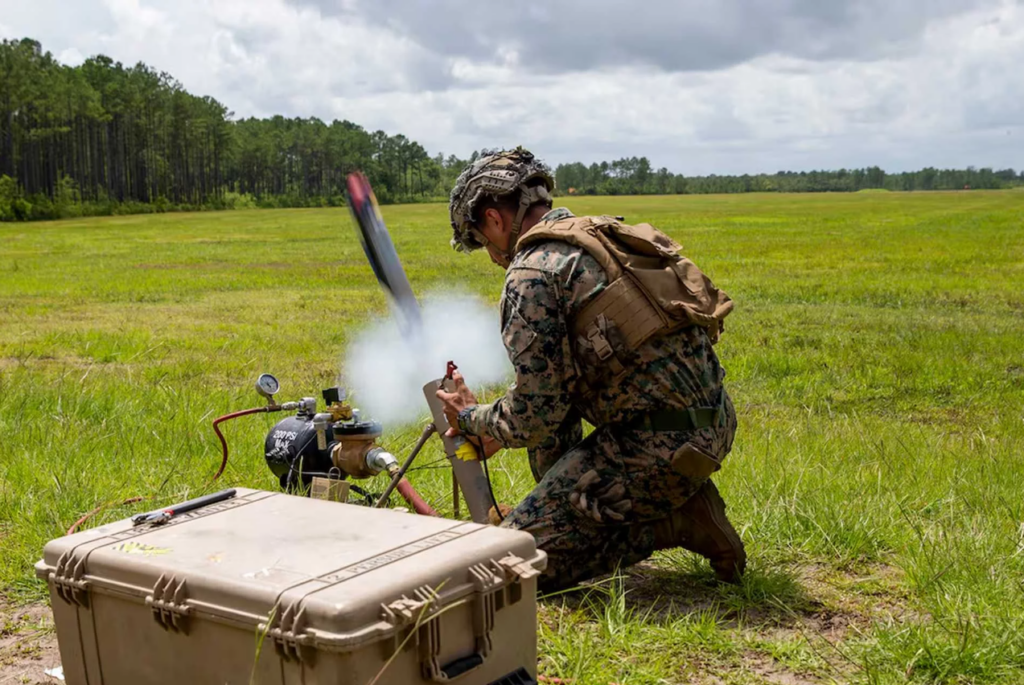U.S. Marine Corps to Introduce Three New Loitering Munitions into Infantry Battalions
The U.S. Marine Corps is set to receive its first Organic Precision Fires-Light (OPF-L) loitering munitions in January 2026, according to reports. These new systems will first go to two Marine battalions for testing and evaluation by end users in the field. The OPF-L is a lightweight, man-portable loitering munition designed to be used by individual Marines at the squad or platoon level. In April 2024, the U.S. Department of Defense selected AeroVironment, Anduril Industries, and Teledyne FLIR for the OPF-L loitering munition program. The contracts were awarded through an open competition involving eight vendors. Each company received an initial contract under an Indefinite Delivery/Indefinite Quantity (IDIQ) agreement: AeroVironment ($8.9M), Anduril ($6.4M), and Teledyne FLIR ($12M). The total IDIQ ceiling is set at $249 million.

Teledyne FLIR will deliver the first 127 OPF-L systems in summer 2025 for testing. Its system uses a vertical take-off and landing (VTOL) quadrotor drone that is recoverable and reusable. The drone has been tested against mobile and stationary targets, including vehicles and personnel. The system is designed for low-altitude operations in urban environments, a zone Teledyne FLIR calls the “Atmospheric Littoral.” The contract includes a five-year base period with a three-year option.
Anduril Industries and AeroVironment are both contributing systems to the U.S. Marine Corps’ OPF-L loitering munition program. Anduril is offering a VTOL quadrotor drone, which includes advanced features such as tracking, guidance, return-to-base, and terminal engagement. This marks a shift from Anduril’s earlier fixed-wing designs like the Altius 700. AeroVironment is providing its Switchblade 300 Block 20, a tube-launched fixed-wing loitering munition. The Block 20 model includes an Explosively Formed Penetrator (EFP) warhead, better flight endurance, improved attack angles, longer range, and stronger battery life. The Switchblade 300 has been in use since 2012, with over 6,000 units produced and tested. It is designed for beyond-line-of-sight attacks on static and moving targets. Both systems are designed to be man-portable and come with a ground control station, training simulator, and supporting gear, meeting the Marine Corps’ OPF-L requirements for 2024–2025 testing.
The OPF-L loitering munition program is part of the U.S. Marine Corps’ broader Force Design 2030 transformation. In 2023, the Marines called for quicker progress in the OPF program, pressing for accelerated procurement and training for Infantry (OPF-I) and Mounted (OPF-M) systems. The Corps conducted 13 tests in various environments under Infantry Battalion Experimentation (IBX). The outcome was an expanded battalion structure from 735 to 811 Marines, including increased surveillance, anti-armor, and indirect fire capabilities. The new structure was formalized in September 2023. Mistral Inc. and UVision were contracted in 2021 for OPF-M integration of the Hero 120 drone onto platforms such as JLTV and Light Armored Vehicle-Medium.
By early 2025, the Marine Corps confirmed plans to deploy OPF-L systems to squads by FY2027. However, officials like Travis Bowden noted challenges in adapting lessons from Ukraine’s drone use. Key issues include battery storage on ships, weather conditions, and electromagnetic spectrum limits. While large-scale drone swarming may not be practical yet, scalable deployment is still a future goal. Progress in targeting, communications, and munitions is needed to fully integrate precision fires at the squad level.

